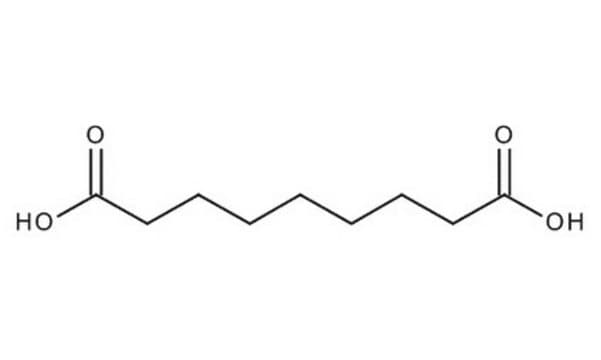246379
Azelaic acid
98%
Synonyme(s) :
Nonanedioic acid
About This Item
Produits recommandés
Densité de vapeur
6.5 (vs air)
Pression de vapeur
<1 mmHg ( 20 °C)
Essai
98%
Forme
powder
pb
286 °C/100 mmHg (lit.)
Pf
109-111 °C (lit.)
Chaîne SMILES
OC(=O)CCCCCCCC(O)=O
InChI
1S/C9H16O4/c10-8(11)6-4-2-1-3-5-7-9(12)13/h1-7H2,(H,10,11)(H,12,13)
Clé InChI
BDJRBEYXGGNYIS-UHFFFAOYSA-N
Vous recherchez des produits similaires ? Visite Guide de comparaison des produits
Catégories apparentées
Description générale
Application
- As a bio-based monomer in the development of biodegradable polymers. These polymers are explored for a range of applications, including packaging materials, agricultural films, and other products where biodegradability is a key requirement.
- As a crucial component in the synthesis of biodegradable copolyester plasticizers for PVC applications.
- As a monomer in the synthesizing poly(glycerol azelaic acid) for tissue engineering applications. Its contributions to biocompatibility, mechanical properties, degradation behavior, and hydrophilicity make it an essential building block for developing advanced biomaterials aimed at enhancing tissue regeneration processes. In drug delivery systems, azelaic acid may play a role in the synthesis of polymers or other compounds used in drug delivery, potentially enhancing medication effectiveness through improved solubility or stability.
- In skincare products.
Mention d'avertissement
Warning
Mentions de danger
Conseils de prudence
Classification des risques
Eye Irrit. 2 - Skin Irrit. 2
Code de la classe de stockage
11 - Combustible Solids
Classe de danger pour l'eau (WGK)
WGK 1
Point d'éclair (°F)
410.0 °F - closed cup
Point d'éclair (°C)
210 °C - closed cup
Équipement de protection individuelle
Eyeshields, Gloves, type N95 (US)
Faites votre choix parmi les versions les plus récentes :
Déjà en possession de ce produit ?
Retrouvez la documentation relative aux produits que vous avez récemment achetés dans la Bibliothèque de documents.
Les clients ont également consulté
Notre équipe de scientifiques dispose d'une expérience dans tous les secteurs de la recherche, notamment en sciences de la vie, science des matériaux, synthèse chimique, chromatographie, analyse et dans de nombreux autres domaines..
Contacter notre Service technique








